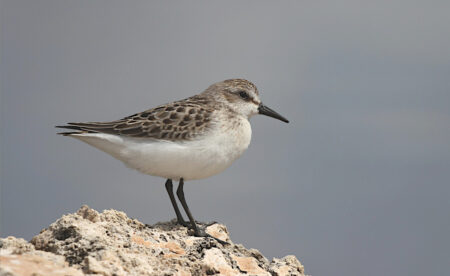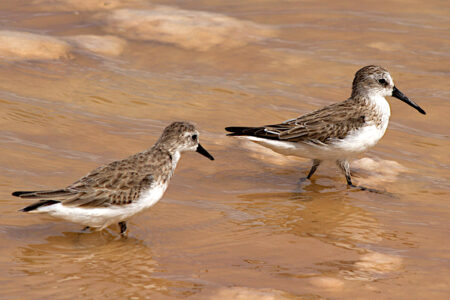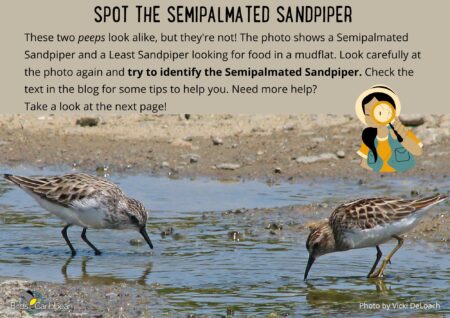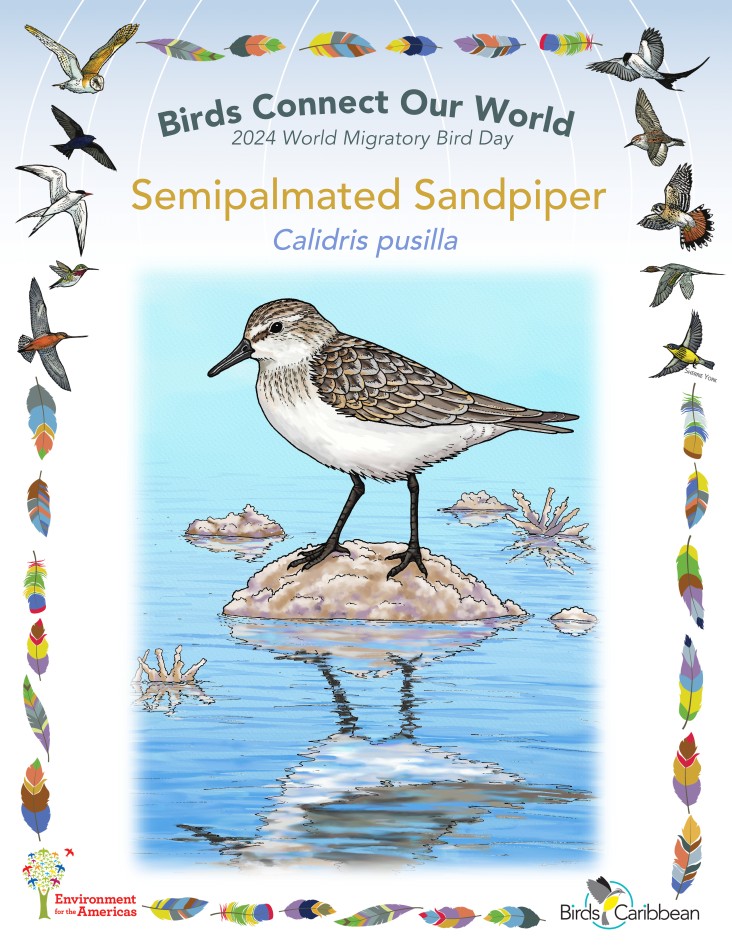Celebrate World Migratory Bird Day (WMBD) with us in 2024! This year’s theme is “Protect Insects, Protect Birds”. Have fun learning about a new migratory bird every day. We have coloring pages, interesting facts, activities, and more. Download for free and enjoy nature with your family at home.
Migratory Bird of the Day: Semipalmated Sandpiper
Meet our first ‘Migratory Bird of the Day’ for 2024, the Semipalmated Sandpiper! Despite being pint-sized and gray-brown in color, this bird is anything but boring! For a start do you know why it has such a curious name? ‘Semipalmated’ refers to the bird’s partially webbed toes—amongst the other small sandpipers this trait is only shared with the Western Sandpiper!
Semipalmated Sandpipers belong to the exclusive ‘peep’ club, a group of small, tricky-to-identify sandpiper species. Semipalmated Sandpipers can be separated from their cousins, the Least and Western Sandpipers, by a few subtle details. Least Sandpipers have yellow legs, a thin slightly down-curved bill, and their upperparts are a warmer brown hue, while Semipalmateds sport dark legs, straighter, slightly thicker bills, and are more gray-brown in color.
Separating Semipalmateds from Westerns can be challenging even for experienced birders since both have gray-brown upperparts and dark legs. Start by looking at bill length and shape. Semipalmated Sandpipers typically have shorter, blunter and straighter bills compared to Western Sandpipers, whose bills are typically longer and curve down slightly at the tip. Western Sandpiper can also look ‘chunkier’ and more ‘front-heavy’. You can find some more great ID tips for separating peeps in our video here (be sure to read the caption too!).
Though tiny, Semipalmated Sandpipers are mighty when it comes to migration! They travel thousands of kilometers from their breeding areas in the Arctic to their wintering grounds in South America with the Caribbean serving as an essential pit stop to refuel. On migration they are often found in flocks (sometimes of thousands of birds), and often with other ‘peeps’. They feast on aquatic invertebrates that live in the surface layer of the muddy habitats they prefer. You can spot them on mudflats, beaches, on the edges of ponds and lagoons, and even in muddy agricultural areas!
Sadly, Semipalmated Sandpiper populations are in decline, and they’re currently listed as Near Threatened by the IUCN. Habitat loss, hunting, and changes in their food supply pose threats to these birds during the course of their long journey. That’s why it’s crucial to protect wetlands across the Caribbean and ensure that these tiny travelers have safe places to rest and feed on their amazing journeys south each year. Learn more about this species, including its range, photos, and calls here. Great news! If you’re in the Caribbean, thanks to BirdsCaribbean, you have free access to Birds of the World and you can find out even more in the full species account of this bird!
Thanks to Alex Sansom for the text and Arnaldo Toledo for the lovely illustration!
Color in the Semipalmated Sandpiper
Download the Migratory Birds of the Day Coloring Page! Use the picture above and the photos on this page as your guide, or look up pictures of the bird online or in a bird field guide if you have one. Share your colored-in page with us by posting it online and tagging us @BirdsCaribbean #WMBD2024Carib
Listen to the calls of the Semipalmated Sandpiper
The calls of the Semipalmated Sandpiper include a strident “jer-jer-jer-jer-jer” as well as softer chirping calls made when in flocks and sometimes in flight.
Enjoy these photos of Semipalmated Sandpipers


Activity of the Day
 FOR KIDS: Test your shorebird ID skills with our “Spot the Semipalmated Sandpiper” challenge! Small sandpipers or ‘peeps’ can look very similar to each other. As well as their small size, they share other similar features—both have plumage that is brown or grey above and white below, pointed black-coloured bills, and a habit of feeding in muddy wetland areas. You can pick out Semipalmated Sandpipers if you look very carefully. You need to pay special attention to their leg color, back color, and bill size and shape. Read the text above, watch our handy ID video, and look closely at the pictures we have shared. Once you’ve done this take a look and see if you can pick out the Semipalmated Sandpiper! (there are some extra tips for you on the second page if you get stuck). You can find the correct answer here.
FOR KIDS: Test your shorebird ID skills with our “Spot the Semipalmated Sandpiper” challenge! Small sandpipers or ‘peeps’ can look very similar to each other. As well as their small size, they share other similar features—both have plumage that is brown or grey above and white below, pointed black-coloured bills, and a habit of feeding in muddy wetland areas. You can pick out Semipalmated Sandpipers if you look very carefully. You need to pay special attention to their leg color, back color, and bill size and shape. Read the text above, watch our handy ID video, and look closely at the pictures we have shared. Once you’ve done this take a look and see if you can pick out the Semipalmated Sandpiper! (there are some extra tips for you on the second page if you get stuck). You can find the correct answer here.
FOR KIDS AND ADULTS: Enjoy this video of a Semipalmated Sandpiper in the wild! This bird is on the mud feeding on ‘biofilm’. This is made up of microorganisms living on the surface of the mud that are stuck together. They eat this by slurping the biofilm into their bill!


